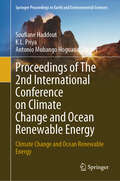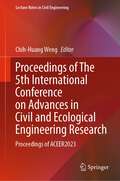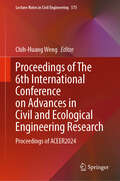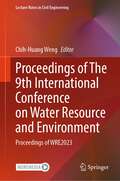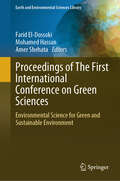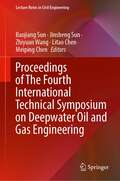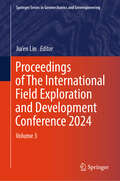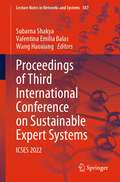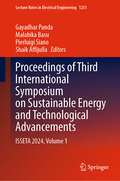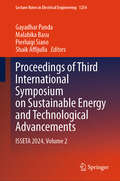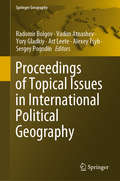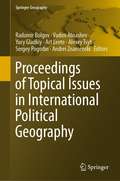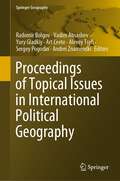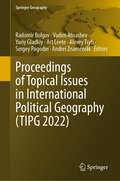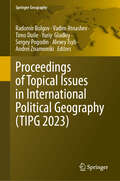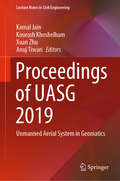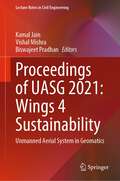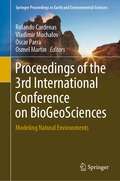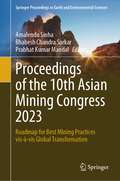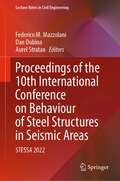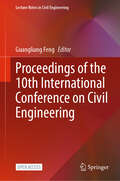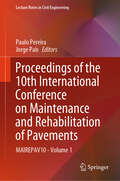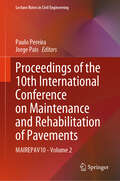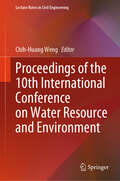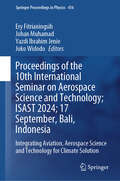- Table View
- List View
Proceedings of The 2nd International Conference on Climate Change and Ocean Renewable Energy: Climate Change and Ocean Renewable Energy (Springer Proceedings in Earth and Environmental Sciences)
by Soufiane Haddout Antonio Mubango Hoguane K. L. PriyaRenewable energy is energy that is collected from renewable resources that are naturally replenished on a human timescale. It includes sources such as sunlight, tides, waves, wind, rain, and geothermal heat. According to BP's-2018 Energy Outlook (EO), renewable energy will be the fastest growing source of energy, increasing fivefold by 2040, thus providing around 14% of global primary energy at this future point in time. On the other hand, climate change is bringing about rising temperatures, which has significant negative impacts on humans and the environment, and transitioning to renewable energy sources, such as biofuels, can help meet this challenge. Transitioning to renewable energy, and reducing reliance on fossil fuels, is one way to help slow down the effects of climate change. While renewables used to be a more expensive option, new clean energy technologies are lowering costs and helping to move economies away from fossil fuels.
Proceedings of The 5th International Conference on Advances in Civil and Ecological Engineering Research: Proceedings of ACEER2023 (Lecture Notes in Civil Engineering #336)
by Chih-Huang WengThis book presents select proceedings of the 5th International Conference on Advances in Civil and Ecological Engineering Research (ACEER 2023). The book covers a wide range of topics, including construction engineering and management hydraulic and hydrologic engineering, air quality and atmospheric pollution, ecological risk assessment and management, restoration and protection of environment, water pollution and treatment, and water recourses engineering. This book also covers state-of-the-art technologies in building sustainable city, resilient buildings, and sustainable issues in relating to civil engineering. It will be useful for researchers and engineers working in the field of civil and ecological engineering.
Proceedings of The 6th International Conference on Advances in Civil and Ecological Engineering Research: Proceedings of ACEER2024 (Lecture Notes in Civil Engineering #575)
by Chih-Huang WengThis book compiles the selected papers from the 6th International Conference on Advances in Civil and Ecological Engineering Research (ACEER 2024). It encompasses various subjects, including construction engineering and management, green building, transportation engineering, earthquake engineering, geotechnical engineering, hydraulic and hydrologic engineering, environmental restoration and protection, water pollution control and treatment, water resources engineering, and waste utilization in construction. This book also delves into cutting-edge technologies to foster sustainable cities and resilient buildings and address sustainability concerns related to civil engineering. The book will be a useful reference material for researchers, practitioners, and engineers in civil and ecological engineering.
Proceedings of The 9th International Conference on Water Resource and Environment: Proceedings of WRE2023 (Lecture Notes in Civil Engineering #468)
by Chih-Huang WengThis book presents selected contributions of the 9th International Conference on Water Resource and Environment (WRE 2023) which is held in Matsue, Japan, November 21-24, 2023. The book discuses a wide range of topics, including Hydraulics, Hydrology and Water Resources Engineering, Environmental Engineering and Sustainability, Indoor Environments, Risk Analysis, Safety and Security, Ocean and Offshore Engineering; Ships and Floating Structures, Coastal Engineering. The chapters in this book are very useful to professionals and academicians for improving their work practice.
Proceedings of The First International Conference on Green Sciences: Environmental Science for Green and Sustainable Environment (Earth and Environmental Sciences Library)
by Mohamed Hassan Farid El-Dossoki Amer ShehataThis book includes recent articles with new findings in Mathematics and Computer Science, Microbiology and Biotechnology, Environmental Science and Oceanography, Physics and Physical Chemistry, Chemistry, and Biochemistry. Also, it contains some articles on the state of the art. The books shows the interaction of the different disciplines of basic sciences and their roles to achieve the green environment and sustainable development via the application of green sciences. Also, the data and information in this book include solving problems in the statistic statistical and computer analysis of many experimental data; broaden the understanding for of many environmental phenomena; broaden the understanding on of how many green synthetic materials could be achieved and examples of their application in biochemistry and microbiology fields; explain how the basic sciences can help in the sustainable development; and explain how deep learning could be used in predicting some phenomena. Additionally, the book enriches understanding of many microbiological and biochemical phenomena and provides complete instructions for many biotechnological aspects. It provides complete instructions for representative waste treatment; enriches understanding of how some biochemical compounds could be tested for representative disease management; case studies that illustrate newly developed equation equations in physics; and summarizes the latest studies in the completeness between basic sciences and climate changes.
Proceedings of The Fourth International Technical Symposium on Deepwater Oil and Gas Engineering (Lecture Notes in Civil Engineering #246)
by Baojiang Sun Zhiyuan Wang Jinsheng Sun Litao Chen Meiping ChenThis book is a compilation of selected papers from the Fourth International Technical Symposium on Deepwater Oil and Gas Engineering & The Third International Youth Forum on Gas Hydrate, held in Qingdao, China in December 2021. The work focuses on the advancement of techniques for the deepwater oil and gas exploitation and natural gas hydrate exploitation. The book introduces new ideas for exploring deepwater oil and gas hydrate in a safe and efficient way. Advances of the natural gas hydrate pilot production in South China Sea, in oil and gas flow assurance and emerging technologies based on clathrate hydrate will be presented. It is a valuable resource for both practitioners and academics working in the field of deepwater oil and gas engineering.
Proceedings of The International Field Exploration and Development Conference 2024: Volume 3 (Springer Series in Geomechanics and Geoengineering)
by Jia'En LinThis book compiles selected papers from the 14th International Field Exploration and Development Conference (IFEDC 2024). The work focuses on topics including Reservoir Exploration, Reservoir Drilling & Completion, Field Geophysics, Well Logging, Petroliferous Basin Evaluation, Oil & Gas Accumulation, Fine Reservoir Description, Complex Reservoir Dynamics and Analysis, Low Permeability/Tight Oil & Gas Reservoirs, Shale Oil & Gas, Fracture-Vuggy Reservoirs, Enhanced Oil Recovery in Mature Oil Fields, Enhanced Oil Recovery for Heavy Oil Reservoirs, Big Data and Artificial Intelligence, Formation Mechanisms and Prediction of Deep Carbonate Reservoirs, and other Unconventional Resources. The conference serves as a platform not only for exchanging experiences but also for advancing scientific research in oil & gas exploration and production. The primary audience for this work includes reservoir engineers, geological engineers, senior engineers, enterprise managers, and students.
Proceedings of Third International Conference on Sustainable Expert Systems: ICSES 2022 (Lecture Notes in Networks and Systems #587)
by Valentina Emilia Balas Subarna Shakya Wang HaoxiangThis book features high-quality research papers presented at the 3rd International Conference on Sustainable Expert Systems (ICSES 2022), held in Nepal during September 9–10, 2022. The book focuses on the research information related to artificial intelligence, sustainability and expert systems applied in almost all the areas of industries, government sectors and educational institutions worldwide. The main thrust of the book is to publish the conference papers that deal with the design, implementation, development, testing and management of intelligent and sustainable expert systems and also to provide both theoretical and practical guidelines for the deployment of these systems.
Proceedings of Third International Symposium on Sustainable Energy and Technological Advancements: ISSETA 2024, Volume 1 (Lecture Notes in Electrical Engineering #1251)
by Pierluigi Siano Gayadhar Panda Shaik Affijulla Malabika BasuThis book contains selected papers presented at Third International Symposium on Sustainable Energy and Technological Advancements (ISSETA 2024), organized by the Department of Electrical Engineering, NIT Meghalaya, Shillong, India, during February 24–25, 2024. The topics covered in the book are the cutting-edge research involved in sustainable energy technologies, smart building technology, integration and application of multiple energy sources; advanced power converter topologies and their modulation techniques; and information and communication technologies for smart micro-grids.
Proceedings of Third International Symposium on Sustainable Energy and Technological Advancements: ISSETA 2024, Volume 2 (Lecture Notes in Electrical Engineering #1254)
by Pierluigi Siano Gayadhar Panda Shaik Affijulla Malabika BasuThis book contains selected papers presented at Third International Symposium on Sustainable Energy and Technological Advancements (ISSETA 2024), organized by the Department of Electrical Engineering, NIT Meghalaya, Shillong, India, during February 23–24, 2024. The topics covered in the book are the cutting-edge research involved in sustainable energy technologies, smart building technology, integration and application of multiple energy sources; advanced power converter topologies and their modulation techniques; and information and communication technologies for smart micro-grids.
Proceedings of Topical Issues in International Political Geography (Springer Geography)
by Radomir Bolgov Vadim Atnashev Yury Gladkiy Art Leete Alexey Tsyb Sergey PogodinThis proceedings book addresses the main issues of contemporary political geography and international relations, providing a platform for discussion and collaboration of experts in the fields of Political Geography, Geopolitics, International Relations, and International Law. Participants from all over the world consider the controversies and challenges posed by globalization, focusing, in particular, on the ideologies of globalization and regionalism, migration crises, prevention of ethnic conflicts, and measures to counteract racism, xenophobia, and extremism
Proceedings of Topical Issues in International Political Geography (Springer Geography)
by Andrei Znamenski Radomir Bolgov Vadim Atnashev Yury Gladkiy Art Leete Alexey Tsyb Sergey PogodinThis proceedings book addresses the main issues of contemporary political geography and international relations, providing a platform for discussion and collaboration of experts in the fields of Political Geography, Geopolitics, International Relations, etc. Participants from all over the world consider the controversies and challenges posed by globalization, focusing, in particular, on the ideologies of globalization and regionalism, migration crises, prevention of ethnic conflicts, and measures to promote sustainable development. The content of the book may be interesting to expert community, academics and popular audience.
Proceedings of Topical Issues in International Political Geography (Springer Geography)
by Andrei Znamenski Radomir Bolgov Vadim Atnashev Yury Gladkiy Art Leete Alexey Tsyb Sergey PogodinThis proceedings book addresses the main issues of contemporary political geography and international relations, providing a platform for discussion and collaboration of experts in the fields of Political Geography, Geopolitics, International Relations, etc. Participants from all over the world consider the controversies and challenges posed by globalization, focusing, in particular, on the ideologies of globalization and regionalism, migration crises, prevention of ethnic conflicts, and measures to promote sustainable development. The content of the book may be interesting to expert community, academics and popular audience.
Proceedings of Topical Issues in International Political Geography (Springer Geography)
by Andrei Znamenski Radomir Bolgov Vadim Atnashev Art Leete Alexey Tsyb Sergey Pogodin Yuriy GladkiyThis proceedings book provides selections from the 2022 Topical Issues in International Political Geography (TIPG) meeting. It addresses the main issues of contemporary political geography and international relations, providing a platform for discussion and collaboration of experts primarily in the fields of Political Geography, Geopolitics, and International Relations. Participants from all over the world consider the controversies and challenges posed by globalization, focusing, in particular, on the ideologies of globalization and regionalism, migration crises, prevention of ethnic conflicts, and measures to promote sustainable development. The content of the book will be interesting to experts, academics, and students in these communities.
Proceedings of Topical Issues in International Political Geography (Springer Geography)
by Andrei Znamenski Radomir Bolgov Vadim Atnashev Alexey Tsyb Sergey Pogodin Timo Duile Yuriy GladkiyThis proceedings book provides selections from the 2023 Topical Issues in International Political Geography (TIPG) meeting. This gathering addresses the main issues of contemporary political geography and international relations, providing a platform for discussion and collaboration between an international array of experts primarily in the fields of political geography, geopolitics, and international relations. The first section of this volume focuses on international relations, addressing issues such as multipolarity, small states, transport cooperation, politico-geographical processes, and international security in the context of geographic space. Building on these spatially rooted themes, section two presents contributions that focus on the dual processes of globalization or regionalism. Authors of these chapters use historical frameworks to interrogate the nation state, ideology, identity, symbolisms, sovereignty, and memory. In section three, the focus narrows to specific domestic policies—such as those related to gender, public services, elections, and corruption prevention—situated in contemporary conversations about digital transformations. Section four turns to instruments of cultural policy, examining tourism and (in a new addition in response to developments in the field) education. Similarly, section five introduces a theme new to the conference: migration and socio-demographic processes. These chapters evaluate national, regional, and local aspects of migration and multiculturalism. The final section turns to the still-pressing theme of sustainable development, taking up case studies of nations and international organizations grappling with questions about sustainable growth, political ecology, and environmental culture. The content of the book will be interesting to experts, academics, and students.
Proceedings of UASG 2019: Unmanned Aerial System in Geomatics (Lecture Notes in Civil Engineering #51)
by Xuan Zhu Kamal Jain Kourosh Khoshelham Anuj TiwariThis volume gathers the latest advances, innovations, and applications in the field of geographic information systems and unmanned aerial vehicle (UAV) technologies, as presented by leading researchers and engineers at the 1st International Conference on Unmanned Aerial System in Geomatics (UASG), held in Roorkee, India on April 6-7, 2019. It covers highly diverse topics, including photogrammetry and remote sensing, surveying, UAV manufacturing, geospatial data sensing, UAV processing, visualization, and management, UAV applications and regulations, geo-informatics and geomatics. The contributions, which were selected by means of a rigorous international peer-review process, highlight numerous exciting ideas that will spur novel research directions and foster multidisciplinary collaboration among different specialists.
Proceedings of UASG 2021: Unmanned Aerial System in Geomatics (Lecture Notes in Civil Engineering #304)
by Biswajeet Pradhan Kamal Jain Vishal MishraThis volume gathers the latest advances, innovations, and applications in the field of geographic information systems and unmanned aerial vehicle (UAV) technologies, as presented by leading researchers and engineers at the 2nd International Conference on Unmanned Aerial System in Geomatics (UASG), held in Roorkee, India on April 2-4, 2021. It covers highly diverse topics, including photogrammetry and remote sensing, surveying, UAV manufacturing, geospatial data sensing, UAV processing, visualization, and management, UAV applications and regulations, geo-informatics and geomatics. The contributions, which were selected by means of a rigorous international peer-review process, highlight numerous exciting ideas that will spur novel research directions and foster multidisciplinary collaboration among different specialists.
Proceedings of the 3rd International Conference on BioGeoSciences: Modeling Natural Environments (Springer Proceedings in Earth and Environmental Sciences)
by Vladimir Mochalov Oscar Parra Osmel Martin Rolando CardenasThis book features a selection of works presented in the 3rd International Conference on BioGeoSciences in a unified framework. It focuses on the physical and mathematical modelling of natural processes and environments at different spatial and temporal scales. This interdisciplinary book presents a comprehensive collection of case studies grouped according to the planetary ‘’spheres’’: lithosphere, hydrosphere, atmosphere, magnetosphere and biosphere. It serves as a valuable resource for scientists engaged in natural and exact sciences.
Proceedings of the 10th Asian Mining Congress 2023: Roadmap for Best Mining Practices vis-à-vis Global Transformation (Springer Proceedings in Earth and Environmental Sciences)
by Amalendu Sinha Bhabesh Chandra Sarkar Prabhat Kumar MandalRising concern about climate change and strong societal expectations with increasing complexities of mineral deposits being mined, call for more innovative exploration and exploitation technologies with higher productivity and recovery including eco-friendly strategies and policies in place for long term sustainability of the mineral Industry. It is now ardently necessary to identify and define the best mining practices addressing societal needs.In view of these, The Mining, Geological and Metallurgical Institute of India (MGMI), established way back on 16th January 1906, and one of the oldest institutions of this kind in the world, is organizing the 10th Asian Mining Congress (AMC) during November 06-09, 2023 in Kolkata, India with the Theme, “Roadmap for Best Mining Practices vis-à-vis Global Transformation”. The AMC and International Mining Exhibition (IME), held concurrently, are flagship international events organized by MGMI biennially since its centenary year. This series have provided ample opportunities to all stakeholders including practicing engineers, machinery manufacturers, planners, regulators, academicians, scientists and policy makers, for sharing their knowledge, experience and expertise and exhibit their products that can benefit the mining and mineral industries not only in the Asian region but also globally.This proceeding of 10th AMC contains the articles written by eminent persons and stalwarts in their respective domains. It is a collection of contemporary articles narrating recent advancements in mining sector.
Proceedings of the 10th International Conference on Behaviour of Steel Structures in Seismic Areas: STESSA 2022 (Lecture Notes in Civil Engineering #262)
by Dan Dubina Federico M. Mazzolani Aurel StratanThis volume highlights the latest advances, innovations, and applications in the field of seismic design and performance of steel structures, as presented by leading international researchers and engineers at the 10th International Conference on the Behaviour of Steel Structures in Seismic Areas (STESSA), held in Timisoara, Romania, on 25-27 May 2022. It covers a diverse range of topics such as behaviour of structural members and connections, performance of structural systems, mixed and composite structures, energy dissipation systems, self-centring and low-damage systems, assessment and retrofitting, codes and standards, light-gauge systems. The contributions, which were selected by means of a rigorous international peer-review process, present a wealth of exciting ideas that will open novel research directions and foster multidisciplinary collaboration among different specialists.
Proceedings of the 10th International Conference on Civil Engineering (Lecture Notes in Civil Engineering #526)
by Guangliang FengThis open access book is a compilation of selected papers from the 10th International Conference on Civil Engineering (ICCE2023). The work focuses on novel research findings on seismic technology of civil engineering structures, High-tech construction materials, digitalization of civil engineering, urban underground space development. The contents make valuable contributions to academic researchers and engineers.
Proceedings of the 10th International Conference on Maintenance and Rehabilitation of Pavements: MAIREPAV10 - Volume 1 (Lecture Notes in Civil Engineering #522)
by Paulo Pereira Jorge PaisThis book gathers the proceedings of the 10th International Conference on Maintenance and Rehabilitation of Pavements (MAIREPAV10), held in Guimarães, Portugal on July 24-26, 2024. The conference series has been established to promote and discuss state-of-the-art design, maintenance, rehabilitation and management of pavements. The respective contributions share the latest insights from research and practice in the maintenance and rehabilitation of pavements, and discuss advanced materials, technologies and solutions for achieving an even more sustainable and environmentally friendly infrastructure.
Proceedings of the 10th International Conference on Maintenance and Rehabilitation of Pavements: MAIREPAV10 - Volume 2 (Lecture Notes in Civil Engineering #523)
by Paulo Pereira Jorge PaisThis book gathers the proceedings of the 10th International Conference on Maintenance and Rehabilitation of Pavements (MAIREPAV10), held in Guimarães, Portugal on July 24-26, 2024. The conference series has been established to promote and discuss state-of-the-art design, maintenance, rehabilitation and management of pavements. The respective contributions share the latest insights from research and practice in the maintenance and rehabilitation of pavements, and discuss advanced materials, technologies and solutions for achieving an even more sustainable and environmentally friendly infrastructure.
Proceedings of the 10th International Conference on Water Resource and Environment (Lecture Notes in Civil Engineering #634)
by Chih-Huang WengThis book comprises selected papers presented at the 10th International Conference on Water Resource and Environment (WRE2024) which is held in Hong Kong, December 15-18, 2024. The book discusses a wide range of topics, including Hydraulics, Hydrology and Water Resources Engineering, Environmental Engineering and Sustainability, Indoor Environments, Risk Analysis, Safety and Security, Ocean and Offshore Engineering; Ships and Floating Structures, Coastal Engineering. The chapters in this book are very useful to professionals and academicians for improving their work practice.
Proceedings of the 10th International Seminar on Aerospace Science and Technology; ISAST 2024; 17 September, Bali, Indonesia: Integrating Aviation, Aerospace Science and Technology for Climate Solution (Springer Proceedings in Physics #416)
by Ery Fitrianingsih Johan Muhamad Yazdi Ibrahim Jenie Joko WidodoThis book presents peer-reviewed articles from the 10th International Seminar on Aerospace Science and Technology (ISAST 2024), held in Bali, Indonesia. The conference addresses the issue of climate change from an aeronautics and aerospace perspective. The book contains four subtopics: space sciences, space-related applications, aviation/aeronautics technology, and aerospace technology. The space science subtopic collects information related to the dynamics of the space environment, investigating potential interactions between the space environment and climate change. The space applications section focuses on the monitoring and detection of climate change via remote sensing. Solutions to the climate change problem are investigated in the technology section, divided into aviation and aeronautics technology, and aerospace technology. These subtopics aim to explore the idea of efficient, green, and environmentally friendly aeronautics and aerospace technologies.
